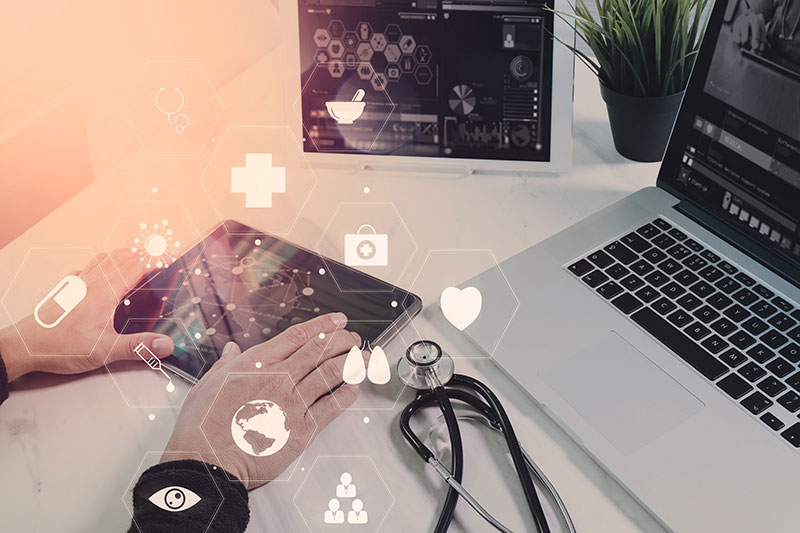While the COVID-19 pandemic has had an effect on virtually all businesses, the severe impact it had on the healthcare industry is the most significant. The digital transformation that the pandemic has steered in is simply unprecedented. In fact, the accelerated pace of this transformation has pushed healthcare businesses to find new ways of working that primarily focus more on securing data and ensuring data privacy, while adhering to the complex set of privacy laws and requirements. Patient data protection has become one of the topmost priorities in a post-pandemic world. Healthcare organizations deal with huge volumes of data and any minor error can harm the patient and damage the reputation of the healthcare facility. Medical data errors like wrong input of patient data, incorrect reporting of data, and missed results (caused by not recording medical data and test results in the EHR system) – are the common cause for adverse medical events in the USA. Medical data can be digitized with the help of medical data entry services.
Medical Data Protection Compromised During the Pandemic
The US healthcare system has encountered several issues – one common issue being inadequate data protection. Healthcare data management has become a critically important aspect, particularly in a post-pandemic situation. COVID-19 made the problem even worse and brought brand new challenges for healthcare facilities. The global pandemic has forced entire sectors of the population to work from their homes. While frontline healthcare workers don’t have the luxury to work from their homes, some healthcare workers were able to work remotely. Healthcare workers who handled patient information (as they worked from home) used various devices to access, transmit, receive, and work on sensitive patient information.
Prior to the pandemic, patient information was only made accessible using devices, networks and tools that were authorized by the healthcare organization – ensuring an adequate level of patient data protection. However, many such stringent device policies have been relaxed now to ensure continuous and smooth operation of hospitals and clinics. This could compromise patient data security and have legal consequences. Even without the relaxed rules, it would have been a challenge to track who accessed the information using their personal devices – as there are just too many complications involved.
How to Ensure Data Security
Once the worst effects of the pandemic passed, several healthcare facilities opened their doors to patients, for in-person visits and other needs. However, even in those facilities, many healthcare workers are still functioning remotely – causing considerable risk in patient data protection due to unsecured networks, personal devices etc. Healthcare providers have many restrictions – one of which is very inadequate budget to upgrade their cyber security measures. As a result, they are quite vulnerable to data breaches. After the pandemic, healthcare providers are facing a wide range of challenges – and rising data breaches are prominent among the existing issues. By focusing on accurate patient identification, healthcare providers can solve many of these problems. Here discussed are some important tips to ensure data protection in a post-pandemic world –
- Validate the Device Used to Access the Network – Healthcare facilities may encounter several ownership models – corporate owned, BYOD, edge devices and cloud models – all of which need some sort of access to patient data. Prior to allowing any device to access a patient resource or data, it is important to evaluate whether or not there are threats that exist on a device network. A platform that allows for the provisioning of any device, including corporate-issued and employee-owned, is vital. This in turn will allow IT teams to have maximum visibility over all endpoints that are being used to access healthcare data.
- Tighten Data Security – Instead of relying on insufficient and forgotten passwords and usernames, healthcare organizations need to use more secure technologies like digital certificates that combine biometric capabilities like facial recognition. This not only removes the problem for healthcare workers to consistently enter or memorize strong passwords, but also improves user experience by unlocking the single-sign-on capabilities. Eliminating passwords needs to be coupled with the ability to establish a relative relationship between the user and the data being accessed. Granting access after the correct username and password being entered is simply not enough. As per Verizon’s 2020 Data Breach Investigations report, compromised passwords are responsible for about 81 percent of all hacking-related data breaches. Limiting simple password access while governing the capabilities that are granted to users by default needs to be solely within your healthcare organization’s capacity. IT staff must be fully given the responsibility to examine key security attributes like – where the employee is connecting from, which type of device, time and location, and security of network.
- Verify Networks – It is important to implement definite policies that dictate how data accessed can benefit healthcare organizations. Access to sensitive patient data needs to be from trusted networks. It is important to ensure that the healthcare workers are not inadvertently accessing rogue networks that may be a launching for data breach. For instance, deploying a per-app VPN is by far one of the best and most secure user experiences for remote workers. A per-app- VPN is an encrypted split-tunnel that allows the mobile user to connect to company resources via a secure SSL connection and access personal apps and websites via the public internet. Only company-approved apps (as opposed to malware) access the secure tunnel and ultimately the protected corporate resource.
- Analyze Applications That Access Data – Healthcare organizations need to only allow access to their data from apps that they literally trust and are easy to manage. However, even for trusted apps, it is important to implement DLP (Data Loss Prevention) policies dictating how, and with whom data can be shared. If an app, or even the user or device becomes untrusted, companies should have the ability to revoke access to a cloud service, remove an untrusted app, and delete sensitive data from the device.
- Protect Threats in Real-time – Generally, data hackers tend to target remote workers with mobile phishing attacks via SMS, messaging apps and email. In fact, social media platforms have become a common avenue for these kinds of data infiltration. Verizon’s 2020 Data Breach investigations report found 22 percent of breaches involved social media attacks. To combat phishing attacks, automation and machine learning (ML) can be utilized to detect threats and take proactive action to prevent users from opening malicious links. Understanding the threat posture of a device is a critical aspect in this area. For instance, it is important to verify whether the device has the ability to detect phishing URLs, malware, zero-day exploits, and risky network conditions. In case of mobile, it is important to check whether there is a mobile threat detection solution in place. In short, it is important to build comprehensive defences that consider all aspects of the attack vectors, including device, network, application and phishing attacks. However, detecting threats is not enough, it is equally important to respond to threats as they emerge. A good solution is to mount a defence mode like – warning the user, blocking access to a cloud resource – as and when any suspicious activity is detected.
Healthcare data is highly sensitive and changes constantly, and you need to adhere to government regulations. Data management in healthcare requires a strategic approach whereby the three aspects of data quality, security and interoperability are properly addressed. Healthcare organizations operating in the post-pandemic time need to consider all the above-mentioned aspects to get prepared for a secure and productive future. The above-discussed steps will ensure how health data can be effectively managed, while staying firmly committed to data privacy and security. Partnering with a data entry outsourcing company that has data security built into their processes, IT infrastructure and network is critical to prevent security breaches and data misuse during the post-pandemic time.





